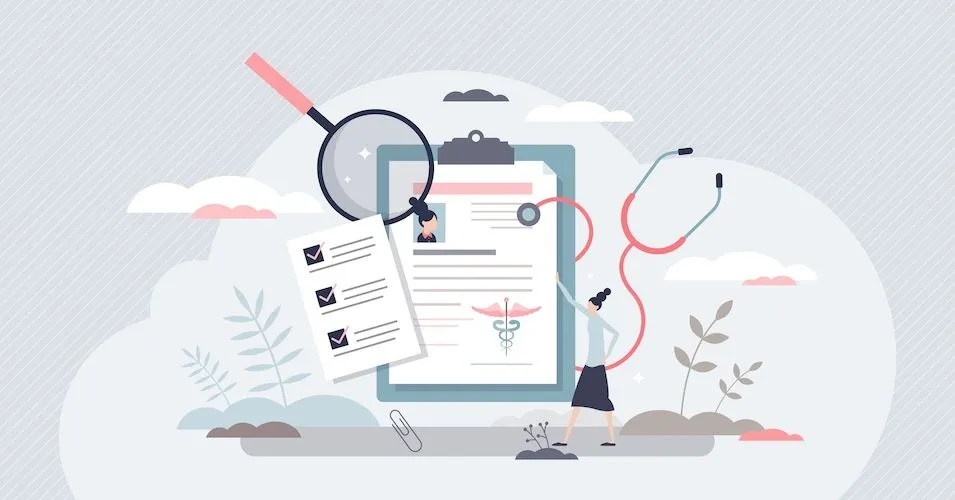Tracking Your CLL Labs in HealthTree Cure Hub

On May 7th, Mariana Castro, an international medical graduate and HealthTree Patient Navigator, shared how you can become a more informed CLL patient by tracking CLL labs in HealthTree Cure Hub, a platform designed to empower CLL patients with detailed insights into their health data. Watch the event's recording or read the summary below!
What is CLL?
Chronic lymphocytic leukemia (CLL), known for its slow progression, is characterized by the accumulation of monoclonal B lymphocytes in the bone marrow. This accumulation disrupts normal blood cell production, often leading to insufficient red blood cells, platelets, and functional white blood cells, making patients susceptible to infections and other complications. CLL generally manifests without symptoms; many patients discover their condition incidentally through routine blood work.
Does CLL Show Up in Blood Work?
One of the key topics in Mariana’s presentation was the significance of lab tests in monitoring CLL. She explained that regular blood tests, such as complete blood counts (CBC), are critical as they provide detailed information about the levels of different blood cells, which can indicate the progression of the disease.
Moreover, she discussed the "watch and wait" approach commonly adopted in CLL treatment, where active treatment is not immediately necessary. Instead, ongoing monitoring of the patient’s condition is essential to determine the right moment for intervention, if needed. This approach underscores the importance of regular lab tests and close observation of CLL’s progression.
How Does HealthTree Cure Hub Track CLL Labs?
HealthTree Cure Hub aids in this by allowing patients to securely connect their medical records and view their lab results in a user-friendly interface that graphically displays trends over time.
Mariana introduced the comprehensive features of HealthTree Cure Hub, which tracks lab results and provides detailed genetic information. The platform supports patients in making informed decisions about their care in consultation with their healthcare providers.
The presentation concluded with Mariana providing a walkthrough on how to connect medical records to HealthTree Cure Hub.
Overall, Mariana’s presentation served as a helpful guide for CLL patients navigating their diagnosis and treatment, empowering them with knowledge and tools to monitor their condition in HealthTree Cure Hub.
Audience Q&A
During the event, Mariana answered several patient questions. Some of these included:
- Is the diagnostic criterion of 5,000 or more lymphocytes unique to CLL, and how does it differ from those with SLL? (Timestamp 47:43)
- What percentage of cells with the 11p deletion is required for it to have serious health implications? (Timestamp 51:12)
- How is my lab information kept safe in HealthTree CureHub? (Timestamp 54:46)
- Does CLL always show up in blood tests? (Timestamp 1:02:20)
- What tests will I need during my follow-up visits? (Timestamp 1:03:30)
To listen to the answers to these questions, we invite you to watch the event recording by clicking here.
Join the HealthTree for CLL Newsletter to Learn More!
We invite you to click the button below to subscribe to the HealthTree for CLL newsletter and stay updated on the latest advancements in CLL.
Join the HealthTree for CLL Newsletter
On May 7th, Mariana Castro, an international medical graduate and HealthTree Patient Navigator, shared how you can become a more informed CLL patient by tracking CLL labs in HealthTree Cure Hub, a platform designed to empower CLL patients with detailed insights into their health data. Watch the event's recording or read the summary below!
What is CLL?
Chronic lymphocytic leukemia (CLL), known for its slow progression, is characterized by the accumulation of monoclonal B lymphocytes in the bone marrow. This accumulation disrupts normal blood cell production, often leading to insufficient red blood cells, platelets, and functional white blood cells, making patients susceptible to infections and other complications. CLL generally manifests without symptoms; many patients discover their condition incidentally through routine blood work.
Does CLL Show Up in Blood Work?
One of the key topics in Mariana’s presentation was the significance of lab tests in monitoring CLL. She explained that regular blood tests, such as complete blood counts (CBC), are critical as they provide detailed information about the levels of different blood cells, which can indicate the progression of the disease.
Moreover, she discussed the "watch and wait" approach commonly adopted in CLL treatment, where active treatment is not immediately necessary. Instead, ongoing monitoring of the patient’s condition is essential to determine the right moment for intervention, if needed. This approach underscores the importance of regular lab tests and close observation of CLL’s progression.
How Does HealthTree Cure Hub Track CLL Labs?
HealthTree Cure Hub aids in this by allowing patients to securely connect their medical records and view their lab results in a user-friendly interface that graphically displays trends over time.
Mariana introduced the comprehensive features of HealthTree Cure Hub, which tracks lab results and provides detailed genetic information. The platform supports patients in making informed decisions about their care in consultation with their healthcare providers.
The presentation concluded with Mariana providing a walkthrough on how to connect medical records to HealthTree Cure Hub.
Overall, Mariana’s presentation served as a helpful guide for CLL patients navigating their diagnosis and treatment, empowering them with knowledge and tools to monitor their condition in HealthTree Cure Hub.
Audience Q&A
During the event, Mariana answered several patient questions. Some of these included:
- Is the diagnostic criterion of 5,000 or more lymphocytes unique to CLL, and how does it differ from those with SLL? (Timestamp 47:43)
- What percentage of cells with the 11p deletion is required for it to have serious health implications? (Timestamp 51:12)
- How is my lab information kept safe in HealthTree CureHub? (Timestamp 54:46)
- Does CLL always show up in blood tests? (Timestamp 1:02:20)
- What tests will I need during my follow-up visits? (Timestamp 1:03:30)
To listen to the answers to these questions, we invite you to watch the event recording by clicking here.
Join the HealthTree for CLL Newsletter to Learn More!
We invite you to click the button below to subscribe to the HealthTree for CLL newsletter and stay updated on the latest advancements in CLL.

about the author
Megan Heaps
Megan joined HealthTree in 2022. She enjoys helping patients and their care partners understand the various aspects of the cancer. This understanding enables them to better advocate for themselves and improve their treatment outcomes.
More on HealthTree Programs
Trending Articles

Get the Latest Chronic Lymphocytic Leukemia Updates, Delivered to You.
By subscribing to the HealthTree newsletter, you'll receive the latest research, treatment updates, and expert insights to help you navigate your health.











